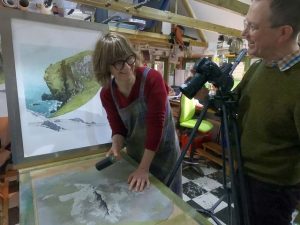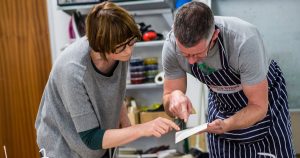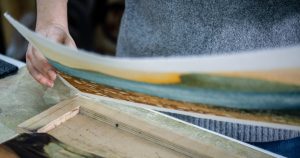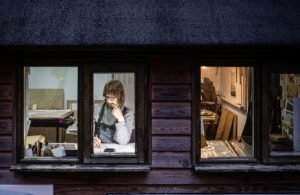I have been starring in a film of my own life over the past ten days or so. We’ve documented one of my linocuts from drawing to finished edition, the goal being to relax and inform others with a slow film about printmaking, rather than an educational video about specifics. The result is a film that’s as much about the passing of time as it is about technique. We’ve deliberately kept things as silent as we can, bar a couple of snatches from Jane Eyre and Miss Marple before I got into the swing of switching off during takes. I had to shut up too; I never realised how much non-sensical muttering I do until I didn’t.
We both knew it would be tricky. I am viciously impatient of anything that gets between me and my print. Plus, used to being alone in the studio, I’m inclined to trip over (kick) cables, cameramen and tripods.

Thankfully Mr B specialises in working unobtrusively and never expected me to pretend to do anything just for the camera. The worst he did was to make me wait while he set up shots and ask me to hit a specific mark from time to time. We finished with him imagining that I barely conceded to any of his directions and me knowing that the Pope will be in touch shortly to celebrate my saintly abundance of patience and good will.
Watching the film was as close to an out of body experience that I ever wish to experience and certainly the death of my vanity. There’s no posing for the camera when deep in concentration. In many respects it was an encouraging trade-off. I found it very easy to forget how I looked in terms of appearance because I was so interested by what I could do in terms of print. That said, I gradually found myself thinking that something was missing; that the me on film should be referring to a colour plan, or at least a to-do list, instead of just staring into the middle distance with unbrushed hair. It seemed such an inadequate approach.
We set out to make a film to highlight the time, focus and creativity involved in printmaking and I think we’ve done it. For my part, I’m pleased that watching it has made me pause and appreciate how lucky I am that the colour plans and to-do list are reliably spooling away, hidden inside my head, desipte the unbrushed hair. For everyone else, I hope it says a lot about what goes into making a print and a little about my methods. As for Doris, I can only apologise. She’s a starlet out of control.
This week on the Ask an Artist podcast we discuss writing rather than filming, but you should listen anyhow. The epic print film can be seen on my YouTube channel at Laura Boswell Printmaker for your viewing pleasure. Choc ices optional.


